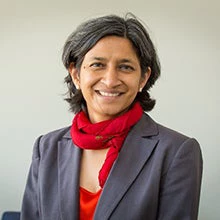 Women workers in Indian factory
Women workers in Indian factory
What happens when women get the opportunity to work?
For Roshaneh Zafar, a service-driven path took her from the international development world to starting Kashf, a microfinance corporation that has served more than 750,000 Pakistani women entrepreneurs.
Maithreyi Rajasingam’s job as the head of the civil society organization Viluthu led her to create Sri Lanka’s Amara forums, a platform for women to be heard in political processes.
Madhukala Adhikari did mason training in Nuwakot, Nepal, to become a construction worker and help rebuild her community after the 2015 earthquake.
And Jahnnobi Rahman, who we met in Bangladesh, parlayed a software engineering career into Relaxy, a startup that is making affordable mental health care accessible to more Bangladeshis.
These and other stories of South Asia’s working women make one thing clear: Women in the workforce don’t just open up opportunities for themselves, they also create possibilities for others. Working women earn money to improve the lives of their families, and they enrich their communities and national economies.
However, only 1 in 4 women in South Asia can share a similar story. South Asia has one of the lowest rates of female labor force participation in the world at 26 percent, less than other regions with comparable incomes and growth trends.
“We cannot defeat poverty with half the world’s population on the sidelines,” World Bank President Ajay Banga reminded us at our 2023 Annual Meetings, referring to the lagging participation of women in the global workforce.
This rings true in South Asia. When considered against South Asia’s ambitious development goals and slowing growth, the fact that so many millions of women aren’t engaged in productive employment represents a hugely missed opportunity.
Many South Asian women credit their families for helping clear their path to a career, but where does that leave women and girls who aren’t lucky enough to have family support?
Although entrenched social and cultural norms pose barriers, the right policies, infrastructure, and services can clear the path for more women to work. Efforts that create opportunities for women, free up women’s time for paid work, eliminate discriminatory laws, and improve safety for women outside the home can help counter social norms and take the pressure off family support in determining a woman’s prospects for work.
To help women thrive in South Asia’s workforce, here are a few focus areas of the World Bank’s work.
More opportunities for women
Supporting the expansion of sectors that create jobs for women, such as the care economy and tourism, can bring more women into the workforce.
The growth of Bangladesh’s garment sector, for example, has led to an increase in working women in the country, from 21 percent in 1990 to 38 percent in 2022. The World Bank’s NARI project was the first of its kind to support the employment of poor and vulnerable rural Bangladeshi women in the ready-made garments industry.
Improving women’s employment prospects in high-growth, high-income potential sectors is equally critical. Targeted vocational training and education, especially in science, technology, engineering, and mathematics, can give women the skills necessary to secure jobs in industries such as tech and financial services, which are typically dominated by men. The World Bank’s Human Capital Recovery and Resilience Project is providing women in Bhutan with information and communication technology and vocational training so that they can qualify for skilled occupations. In Nepal, the Youth Employment Transformation Initiative is focused on skills training for women and placing them in jobs that maintain and upgrade public infrastructure.
Free up women’s time
Caring for family members, including children and the elderly, is mostly a woman’s responsibility across South Asia. Men’s share of unpaid care work in Pakistan and India is less than 10 percent, compared to the global average of 27.5 percent. Expanding access to quality, affordable child and elderly care are among the most important investments countries can make to empower women, and the World Bank is looking to do more in this area. A recent World Bank study in South Asia revealed that preschool services resulted in a 10-percentage point increase in women’s labor force supply, less time spent on care activities, and improved women’s attendance at work.
Tackling discriminatory laws
Many countries still have discriminatory labor legislation, such as laws limiting the sectors where women can work or their total work hours. Reforming such laws and introducing policies that support the recruitment and retention of women, including maternity leave, can help women stay in the workforce over the long term and through different life stages.
To support such laws, in Sri Lanka the World Bank’s policy operations promote reforms through a Gender Equality Bill, which lets women challenge discriminatory legislation. In Pakistan, a program pushed for the adoption of new laws, which have helped improve conditions for 4 million home-based workers and 3.7 million vulnerable women in the private sector.
Safer workspaces and transport
Legal reforms are also necessary so that women feel safe in public and at work. Thirty to 40 percent of women experience sexual harassment In South Asia’s workplaces. In response, the World Bank is working with Bangladesh’s labor ministry to develop a mechanism for reporting sexual harassment in workplaces.
Commuting safely is also a concern for women and girls. In India, the World Bank supported the government to develop a design toolkit for safer public transport for women.
Countries that are serious about growing their economies and reaching their development goals will succeed only if they bring more women into the workforce.
Currently, South Asian women simply don’t have the same economic opportunities as men. It’s time to create pathways for women to fully participate in the economy. Only then can we hope to have more Maithreyis and Jahnnobis to drive prosperity in South Asia. Let’s #ClearHerPath, so that future generations of women and girls can follow in their footsteps.
Learn more about the World Bank's #ClearHerPath campaign to boost women’s participation in the workforce in South Asia: www.worldbank.org/clearherpath.



Join the Conversation